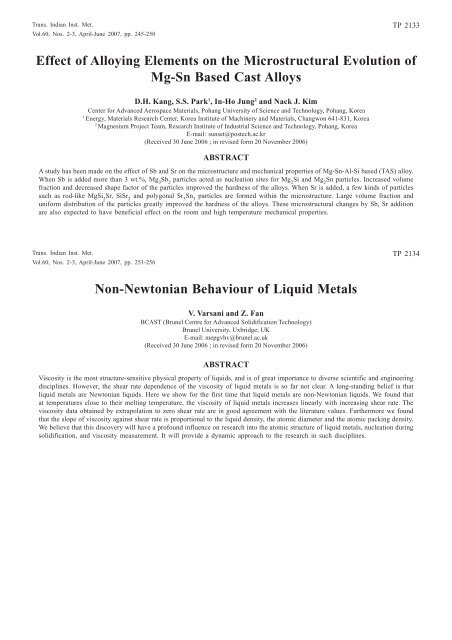Vol.60, Nos. 2-3 - Indira Gandhi Centre for Atomic Research
Vol.60, Nos. 2-3 - Indira Gandhi Centre for Atomic Research
Vol.60, Nos. 2-3 - Indira Gandhi Centre for Atomic Research
Create successful ePaper yourself
Turn your PDF publications into a flip-book with our unique Google optimized e-Paper software.
Trans. Indian Inst. Met.<br />
<strong>Vol.60</strong>, <strong>Nos</strong>. 2-3, April-June 2007, pp. 245-250<br />
TP 2133<br />
Effect of Alloying Elements on the Microstructural Evolution of<br />
Mg-Sn Based Cast Alloys<br />
D.H. Kang, S.S. Park 1 , In-Ho Jung 2 and Nack J. Kim<br />
Center <strong>for</strong> Advanced Aerospace Materials, Pohang University of Science and Technology, Pohang, Korea<br />
1<br />
Energy, Materials <strong>Research</strong> Center, Korea Institute of Machinery and Materials, Changwon 641-831, Korea<br />
2<br />
Magnesium Project Team, <strong>Research</strong> Institute of Industrial Science and Technology, Pohang, Korea<br />
E-mail: sunset@postech.ac.kr<br />
(Received 30 June 2006 ; in revised <strong>for</strong>m 20 November 2006)<br />
ABSTRACT<br />
A study has been made on the effect of Sb and Sr on the microstructure and mechanical properties of Mg-Sn-Al-Si based (TAS) alloy.<br />
When Sb is added more than 3 wt.%, Mg 3<br />
Sb 2<br />
particles acted as nucleation sites <strong>for</strong> Mg 2<br />
Si and Mg 2<br />
Sn particles. Increased volume<br />
fraction and decreased shape factor of the particles improved the hardness of the alloys. When Sr is added, a few kinds of particles<br />
such as rod-like MgSi 2<br />
Sr, SiSr 2<br />
and polygonal Sr 5<br />
Sn 3<br />
particles are <strong>for</strong>med within the microstructure. Large volume fraction and<br />
uni<strong>for</strong>m distribution of the particles greatly improved the hardness of the alloys. These microstructural changes by Sb, Sr addition<br />
are also expected to have beneficial effect on the room and high temperature mechanical properties.<br />
Trans. Indian Inst. Met.<br />
<strong>Vol.60</strong>, <strong>Nos</strong>. 2-3, April-June 2007, pp. 251-256<br />
TP 2134<br />
Non-Newtonian Behaviour of Liquid Metals<br />
V. Varsani and Z. Fan<br />
BCAST (Brunel <strong>Centre</strong> <strong>for</strong> Advanced Solidification Technology)<br />
Brunel University, Uxbridge, UK<br />
E-mail: mepgvhv@brunel.ac.uk<br />
(Received 30 June 2006 ; in revised <strong>for</strong>m 20 November 2006)<br />
ABSTRACT<br />
Viscosity is the most structure-sensitive physical property of liquids, and is of great importance to diverse scientific and engineering<br />
disciplines. However, the shear rate dependence of the viscosity of liquid metals is so far not clear. A long-standing belief is that<br />
liquid metals are Newtonian liquids. Here we show <strong>for</strong> the first time that liquid metals are non-Newtonian liquids. We found that<br />
at temperatures close to their melting temperature, the viscosity of liquid metals increases linearly with increasing shear rate. The<br />
viscosity data obtained by extrapolation to zero shear rate are in good agreement with the literature values. Furthermore we found<br />
that the slope of viscosity against shear rate is proportional to the liquid density, the atomic diameter and the atomic packing density.<br />
We believe that this discovery will have a profound influence on research into the atomic structure of liquid metals, nucleation during<br />
solidification, and viscosity measurement. It will provide a dynamic approach to the research in such disciplines.
















